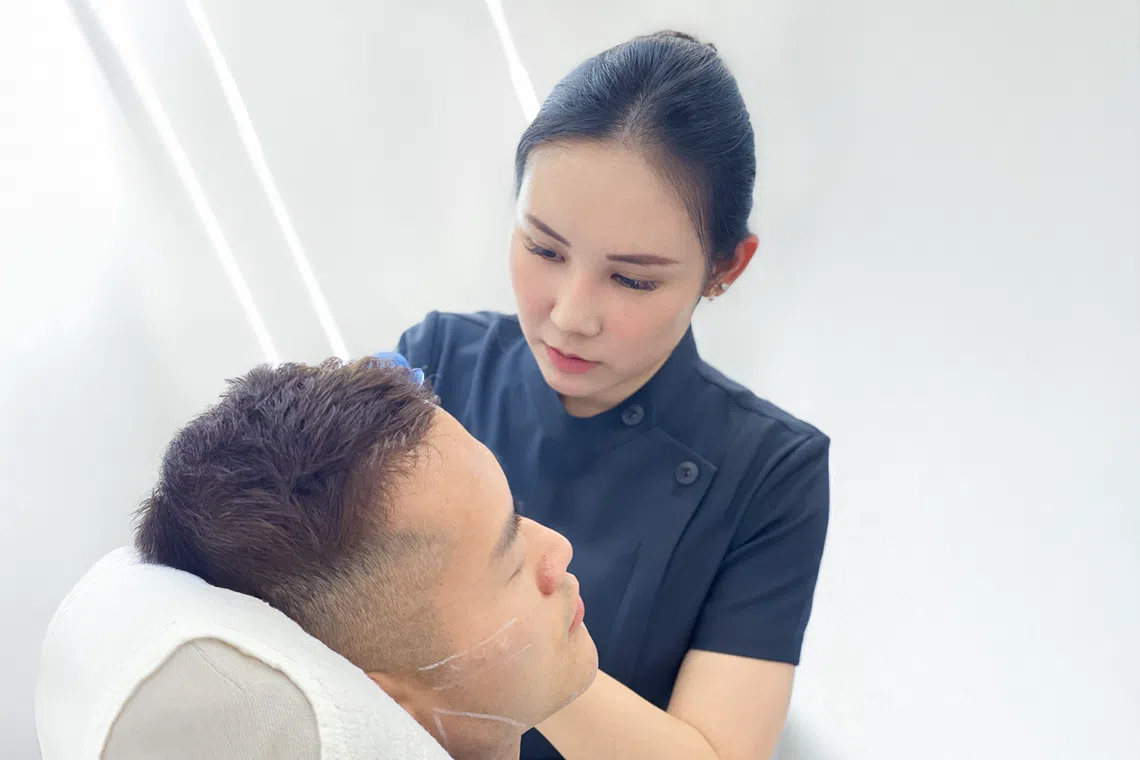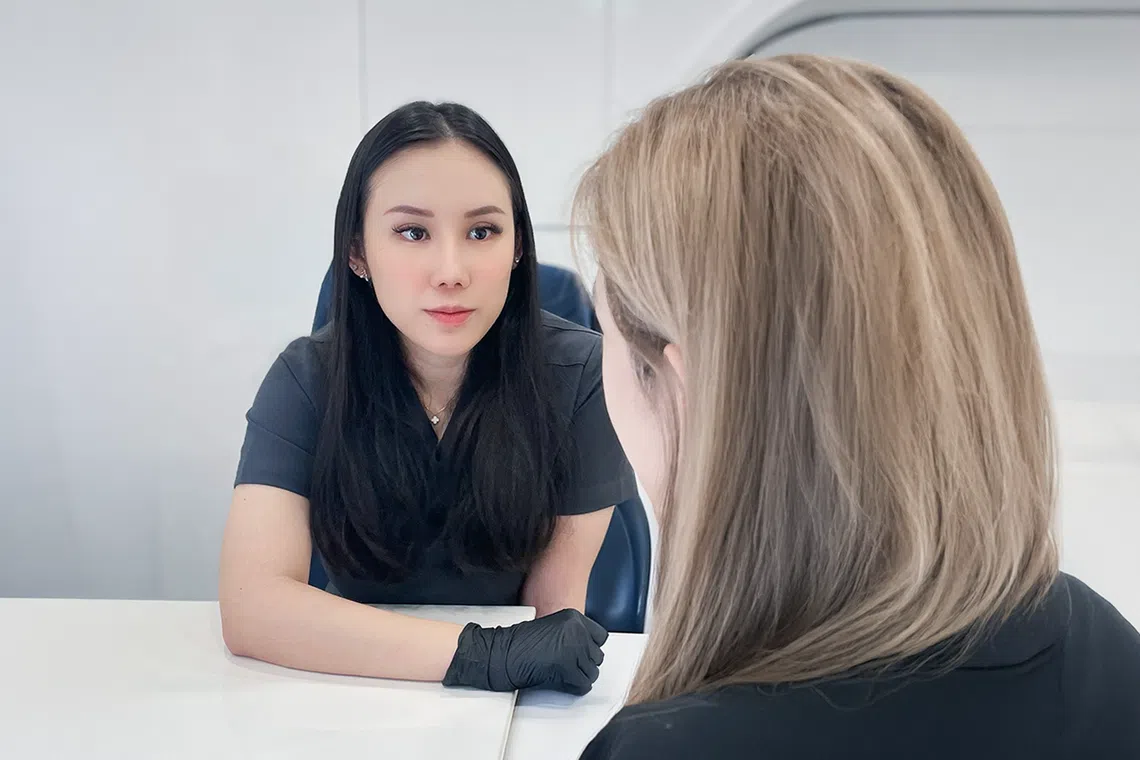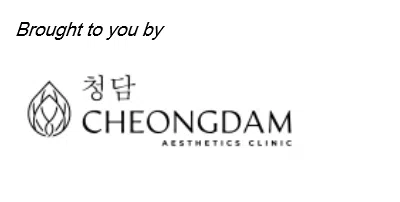BRANDED CONTENT
Spots, scars and signs of ageing: How Korean aesthetic treatment combos help target multiple skin issues at once
At Cheongdam Aesthetics Clinic, your skin’s unique needs are addressed through clinically guided care and customised treatments based on medical evaluations

Treatment plans are tailored to the individual customer depending on their skin concerns.
PHOTO: CHEONGDAM AESTHETICS CLINIC
Follow topic:
Pigmentation that deepens with sun exposure, acne scars that linger long after breakouts fade, and a gradual loss of volume and elasticity – these are just some of the many skin concerns that people often face. Most individuals deal with multiple, overlapping concerns, which is why one-size-fits-all skincare solutions often fall short.
That is where Korean aesthetic protocols come in. Known for their holistic and methodical approach, Korean skin management focuses on treating the skin comprehensively and consistently.
“Combination treatments that address multiple ageing or aesthetic concerns at the same time prolong the results by working synergistically,” says Dr Kara-Anne Tan, senior aesthetic doctor, Cheongdam Aesthetics Clinic
In Singapore, Cheongdam has been adopting this approach since 2017.
Chief aesthetic trainer Ms Tiffany Tan says: “ Cheongdam’s
Drawing from her experience at a dermatology clinic in Gangnam, Korea, Ms Tan says she led her team in adapting proven Korean protocols to meet the needs of patients in Singapore. The result is a localised treatment approach that not only targets common concerns but also considers lifestyle, environmental factors and long-term skin health. Each plan is tailored to the individual, taking into account his or her skin condition, personal goals and medical history.
Targeted results with layered treatments
According to Dr Kara-Anne Tan, the most common concerns among Singaporeans are hyperpigmentation caused by sun exposure or hormonal shifts, persistent acne scarring, and age-related issues such as volume loss and decreased skin elasticity.
She deduces this through a consultation, following a skin analysis – done with a machine commonly used in top Korean clinics and hospitals – that reveals pigmentation levels, hydration, elasticity, texture, and signs of underlying skin damage not visible to the naked eye.

An in-depth consultation is held with the customer after their skin analysis to find out about their treatment goals.
PHOTO: CHEONGDAM AESTHETICS CLINIC
During the consultation, she reviews the results of the analysis alongside her own visual assessment. Then, she discusses with the patient to find out his or her expectations, goals, budget and lifestyle before designing a suitable personalised treatment plan.
A combination of treatments is often offered to take advantage of its synergistic effects. Dr Tan explains that even among patients with similar concerns like acne scarring, the approach can differ significantly. One person might benefit from radiofrequency microneedling and fractional laser to refine skin texture, while another might be better suited for polynucleotide injections
“Customisation is key, as each individual’s skin type, severity of scarring, healing response, and treatment goals are carefully considered before any plan is recommended,” she adds.
When it comes to pigmentation and overall skin quality, one of the many ways to address it at Cheongdam is through its signature Pico Mix & Match Programme
While the Pico Toning Laser focuses on pigmentation with minimal downtime, patients can also upgrade to the Full Pico Laser, which targets deeper pigment and texture issues such as acne scars or enlarged pores.
For patients looking to lift sagging skin, Cheongdam offers the Volformer
Dr Tan explains: “ Volnewmer Shurink Ultraformer MPT
“This pairing is suitable for patients looking for a natural lift without the invasiveness of surgery or fillers,” she adds.
While many of their patients are happy to undergo treatments in Singapore, some are also curious about seeking specialised procedures in Korea, notes chief aesthetic trainer Ms Tan.
In such cases, she shares that they do not discourage it. “Our intention is to serve as a bridge, helping our clients to prepare for their treatments by advising on how to optimise their skin condition, and to maintain or extend their results when they return to Singapore. We can even refer them to our partner clinics in Korea if they are unsure about where to go,” explains Ms Tan.
To maintain this strong connection to Korean protocols and ensure clinical excellence, Cheongdam Aesthetics Clinic also ensures that its team stays updated by participating in training sessions with clinics and professionals in Korea several times a year.
Prep, treat, recover
In line with Korean aesthetic protocols, pre- and post-treatment care is also an important part of the approach at Cheongdam Aesthetics. Drawing on their medical training, the clinic’s doctors focus on preparing the skin, such as calming inflammation or strengthening the skin barrier, so it responds better to treatment, says Dr Kara-Anne Tan. Recovery support, like hydration infusions, is also introduced to help enhance results and reduce downtime, she adds.
For instance, HA (hyaluronic acid) skin boosters are often used after radio frequency microneedling
Chief aesthetic trainer Ms Tan explains: “Although results and recovery time can vary depending on the person and treatments used, our clinical experience shows that combining treatments usually gives better, longer-lasting results with a faster recovery than doing them one by one.”
Dr Tan adds: “When you can achieve better results from combination treatments than single ones, you may reduce the number of sessions required for desired outcomes. That helps to save not only cost, but also time.”
As with all treatments, Dr Tan says a person’s suitability for the treatments depends on the individual. Ultherapy, HIFU, RF and laser-based procedures are not recommended for patients with active skin infections, metal implants in the treatment area, who are pregnant, or have certain medical conditions that affect healing or skin sensitivity.
“We don’t just focus on ‘what’ they want to improve, but also understand the underlying factors that may affect their skin health and treatment outcomes, before designing a personalised treatment plan,” adds Dr Tan.
For more information, visit Cheongdam Aesthetics

Cheongdam Aesthetics’ team is made up of four doctors including (from left) Dr Raymond Cheang, Dr Kara-Anne Tan, Dr Nee Pei Yi and Dr Dennis Teng.
PHOTO: CHEONGDAM AESTHETICS CLINIC


